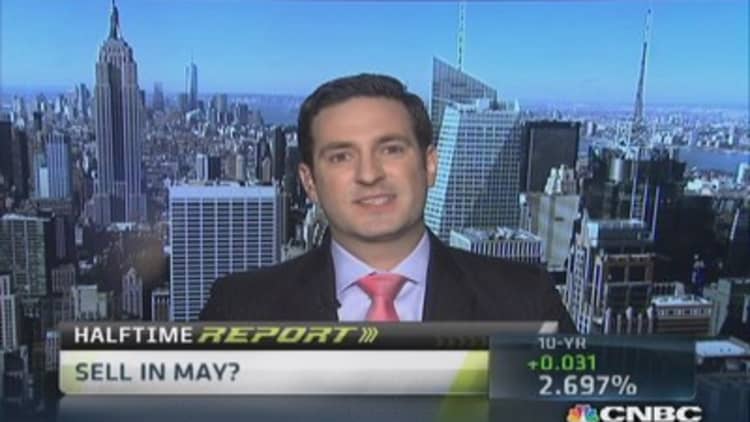
The well-worn rhyme, "Sell in May and go away," has a basis in fact, FBN Securities Chief Market Technician JC O'Hara said Monday.
Looking at data over the past 20 years, O'Hara calculated average returns for the S&P 500 in the May-through-September time frame versus the other seven months.
"We've actually found, on average, over the last 20 years that the sell-in-May, the May through September bucket, was basically responsible for 0 percent of the S&P 500's returns. And I think that is very, very interesting, especially as we are right now. We're basically flat on the year. We're moving sideways. There's a lot of indecision," he said on CNBC's "Halftime Report."

Although the S&P 500 in May was up 65 percent of the time over the past 20 years, O'Hara argued that all of the index's significant gains came October through April.
"So, yes, while you might be up 1 percent, especially if you include the dividends, if you just look at pure, simple price appreciation, we're looking at neutral at best here," he said. "So, you shouldn't really be excited."
Not so, said Cannacord Genuity Chief Equity Strategist Tony Dwyer, who suggested buying aggressively in May.
Dwyer—whose year-end target for the S&P 500 is 2,185—based his view on a twofold perspective.
"Is the fundamental backdrop still bullish for equities, and I think there's no question about that. That's why my target's so high," he said.
Read More Why April's best sector could keep soaring in May
"And secondly, what are the conditions that create a sustainable and market low in an intermediate-term uptrend, and those are a VIX at 20. When the percentage of stocks, S&P stocks, above the 10- and 50-day (moving averages) gets above 20 and 40 percent, respectively. In other words, you kind of get a whoosh. And then that weekly stochastic indicator that I love so much is oversold. Those are the conditions that get you to say, 'OK, now I'm in regardless as long as those fundamentals are still good.'"
Dwyer said that valuation expansion would continue to push stocks higher, although he expects a bit more of a correction in the near term.
"The direction of earnings is driven by economic activity. Economy activity is driven by the slope of the yield curve and availability of money. We've seen the loan demand data pick up pretty appreciably," he said. "The steepness of the yield curve is driven by Fed policy. Even with a rate increase earlier than expected next year, it's still historically cheap, and that's driven by core inflation."
Dwyer was confident about his thesis beyond the May-to-October period.
"All of those factors, even if you look out three or four years, remain positive, which means there's no way that a pension or endowment fund can get 7½ percent unless you're in a levered credit fund, unless you go into equities," he said. "And I think that ultimately is the driver."
Read MoreDon't laugh: There's logic behind 'sell in May'
OptionMonster co-founder Pete Najarian took issue with the sweeping sell-in-May advice, noting that certain sectors, such as financials, could still outperform.
"I just hate the blanket statements," he said. "It's like somebody saying, 'Everything in tech's getting sold.'"
Ritholtz Wealth Management CEO Josh Brown added that the data going back to 1928 suggest that in a mid-term election cycle May on average actually shows a negative 2 percent return.
"So, if that happens again, the question to ask yourself is: Is this really important for me to react to? And I think for most people, probably not," he said.
—By CNBC's Bruno J. Navarro. Follow him on Twitter @Bruno_J_Navarro.


